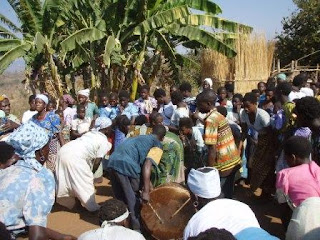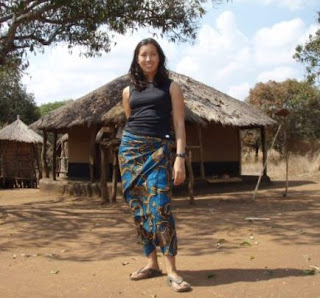The village was located about an hour east of Lilongwe. It was 11km away from the nearest town and paved road. 34 people lived in the community I stayed in – 2 of whom speak some English.
For the first few days of my stay, Sabo, my father for the stay, was in Northern Malawi. As a result, the other English speaker, a woman named Ellis, became my go-to person.

Photo 1: Ellis and I
My Village

Photo 2: The village. On either side of a dirt path were mud huts and beyond those were a variety of storage structures (for maize and groundnuts mostly) and animal enclosures (chicken and pigeon coops, rabbit hutch, pig and goat pens), bathing stalls (with reed privacy shades and stone floors), and a latrine.

Photo 3: The village was located in a hilly area. Malawi has a densely populated rural area (as far as rural areas go anyway!) and this was evident where I was located as the countryside was dotted with many communities.

Photo 4: I stayed in Ellis’ hut. It is a simple mud hut with a thatched roof, divided into 2 rooms – a bedroom, and a sitting area. I stayed in the bedroom, sleeping on a reed mat placed on a metal bed frame – it was surprisingly not uncomfortable!

Photo 5: All of our cooking took place over open fire in the outdoor kitchen area. Most took place in the mud walled wind screen area. In this photo, I’m busily stirring sweet beer – a non alcoholic drink made from maize, served by the vat at weddings.
The Irrigation Site
The village I stayed in was located at one of the sites TLC works in, a large stream diversion irrigation site.

Photo 6: The “garden” is a site that receives stream diversion irrigation (as described in my previous post – it is the same site in fact). The area is divided into 15m x 72m plots, rented out by various farmers. The types of crops grown there include paprika (peppers), maize, sweet potatoes, pumpkins, radish, Irish potatoes, cabbage, and a variety of other crops. Some, such as paprika, are sold, while others are consumed by the villages.

Photo 7: Sabo and I by the gardens.
Day to Day Life

Photo 8: A Meal
Both lunch and dinner consists of nsima served with a relish. Nsima is the Malawian staple food, made out of maize flour. Relish consists of any number of dishes consisting of meat (goat, chicken, or pigeon mostly), beans, vegetables (which include many different kinds of greens – pumpkin, radish, and sweet potato leaves to name a few; Chinese lettuce; cabbage; etc), tasty soya pieces (which really are very tasty!), or fish. In this case, the relish is simply egg and tomato. You roll the nsima into a little ball in your hand, make an indentation with your thumb, and then use it to scoop up the relish to eat.

Photo 9: Cooking Relish
Most cooking takes place over a fire, using three stones to prop up the pot.

Photo 10: School
The kids went to school from 7:30 – 12. The school was a 2 km walk away along a dirt path. Elementary school runs from standard 1 – 9, and high school consists of form 1 – 4.

Photo 11: Collecting firewood
Fire wood provides an important source of fuel, used for almost all cooking. The firewood is collected in the surrounding areas by the women. They go out and chop down small trees, leaving them to dry for a month before returning to gather the wood. The branches are lashed together using the bark of a certain type of tree, and then carried back on one’s head.

Photo 12: Football field
Boys playing football in a field located nearby. The ball used was constructed by the boys out of plastic bags and string.

Photo 13: Pounding Maize
Pounding maize is hard work (I have the blisters to prove it!). The dried maize kernels are pounded using a mortar and pestle to remove the outer layer of the kernels, done prior to grinding into flour.

Photo 14: Sifting corn
After pounding the maize, it has to be sifted to separate the kernels out. The kernels were then brought to the nearest maize mill, which was located a few kilometres away at the nearby army base, to be ground into flour for use in making nsima and porridge.
A Village Wedding
During my stay I had the opportunity to attend a wedding at a nearby village.

Photo 15: Wedding – cooking nsima
Lots of food gets served at the wedding. A ridiculous quantity of nsima gets made, as well as relishes of different kinds of meat (no veggies available!).

Photo 16: Wedding – dancing
A common scene at a village wedding is a crowd gathered round a group of dancers. There are traditional men’s and women’s dances, both performed to the beat of a drum. Anyone may participate, and a large crowd develops to watch.
The bride and groom didn’t actually make their grand appearance until the end of the event. The festivities began at 1pm, and the bride and groom emerged at around 5:30 pm. They were fetched by a crowd of jubilant partygoers, but the couple themselves walked towards the rest of the guests with heads bowed, looking rather solemn. The groom wore a tuxedo, the bride wearing a white gown. They were led to a pair of chairs, which they were sat down on, with female relatives standing behind them. A few speeches were made, then presents and money were presented to the couple. My family left to return home before the end, so I’m not sure what happened at the end!
***
I'm now getting settled in to my new place in Lilongwe, and work is quite busy - but more on that next time!


4 comments:
Awesome pics Kim! I'm just wondering if the vegetarian-ism is still working out, and if it is, how people react to you refusing meat? Keep writing, I love your posts!
Hey Sylvie!
Good question!
I made the decision to eat a bit of meat in the village, if presented with it. Meat was only served on a few occasions (we mostly had beans, tasty soya pieces and eggs). I wasn't a huge fan, but I felt that in a village context, where the animals are raised in a manner completely different than those back in Canada, my values wouldn't be compromised by having a little bit of pigeon.
Outside of the village setting, I have maintained my vegetarianism, however, I have started to eat fish. The majority of the animal protein consumed in Malawi comes from fish. I have found avoiding meat to be reasonably easy, but eating fish has been very helpful with this!
I have been eating with the family that I'm living with, and they had a positive reaction when I told them I was vegetarian, and are being very accomodating.
Hi Kim!
I love reading your posts because you write exactly as you talk so there's a little Kim in my head reading them to me! :) Sounds like you're really having a good time, and getting totally immersed in Malawian life! I have a question about the farmers, are the farmers that participate in the TLC project only those who use the rented fields? Or who gets to participate? I imagine there are many farmers who don't farm the rented fields, what do they do? Or does TLC work with them also, and the rented fields are just an example?
Secondly, what is the role that you will be playing in TLC?
Ok, last question: what's the scariest/most exciting thing you've done so far in Malawi?
Take care and have fun!!!
Later gator, Laura
ps. Can I tell Dayne that you ate a pigeon? I just want to hear his reaction!
Haha, I'm glad that you enjoy having a little Kim in your head reading to you - sounds a little frightening, if you ask me!
So, about the farmers that participate in TLCs programs . . . it is somewhat complicated, and works on a case by case basis.
The typical way things work is that a field coordinator will set up a "club" at a given village, or collection of villages. This club is basically a collection of farmers interested in being involved with the project and may be focused on irrigation or forestry club, depending on the project. With irrigation clubs, one role they have will be to deal with land tenure issues for the site to be irrigated.
The farmers will all have their "rain-fed" fields, which is where they plant during the rainy season, but the irrigated plots typically have to be located elsewhere because of the availability of irrigation water, and often on land not previously used by the given farmer.
Most land here is not “owned” by a given person in the same way as it is in Canada. I haven’t quite figured out just how it works, but for the most part the land that ends up being used by the irrigation clubs are those overseen by a chief or other traditional authority. In these cases, the clubs may appeal to be given the land by this chief, and will make an agreement of some sort with him. The land then becomes that of the club. In other cases, such as at the site I was in, the land was actually “owned” by someone, and that person charged a small fee as rent for people to use the land. In this case, whoever was interested in participating in the program had the opportunity to rent out a plot of land.
As far as what I’m doing . . . I’m on the Monitoring and Evaluation team here. I’m going to talk about that in an upcoming post, so you’ll just have to wait for it!
Post a Comment